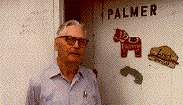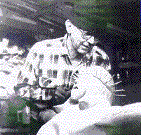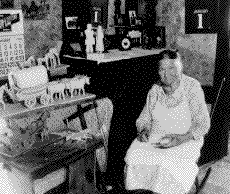|
Anton Pearson, an immigrant originally from Malmo Sweden, is the best known of the woodcarvers of the Smoky Valley. A group of eight figure carvings of the Salvation Army Band on a street corner was exhibited in Sweden in the "MORE SWEDISH THAN SWEDEN" exhibition. |
|
|
|
APPLE TREES existed in Sweden prior to the 1750's. Apples
were squered on the end of the pointed "arms". Today you
find gumdrops. Lindsborg KS.had 10 makers. |
|
|
 |
|
There are several Dala Horse Makers that were interviewed for the grant. One of the most prolific is Ragnar Milstrom, shown in front of his old business location. Ragnar owns a Dala Horse that is ten feet tall which he takes to Scandinavian art fairs across the U.S. He spends winters in Sweden. He has collected old dala horses, and made a display of the different styles he has found. Take a look at the page on Dala Horses |

 HUGO SHOGREN made apple trees, carved figures, and built a
radio station that reached 8 miles on a good day.
HUGO SHOGREN made apple trees, carved figures, and built a
radio station that reached 8 miles on a good day.

 GRANDMA LAWTON carved in Sweden before immigrating to the
U.S. She carved horses, sewed the reins, added small brass
buttons to ornament the bridles. A good collection may be
seen in McPherson,KS.
GRANDMA LAWTON carved in Sweden before immigrating to the
U.S. She carved horses, sewed the reins, added small brass
buttons to ornament the bridles. A good collection may be
seen in McPherson,KS.